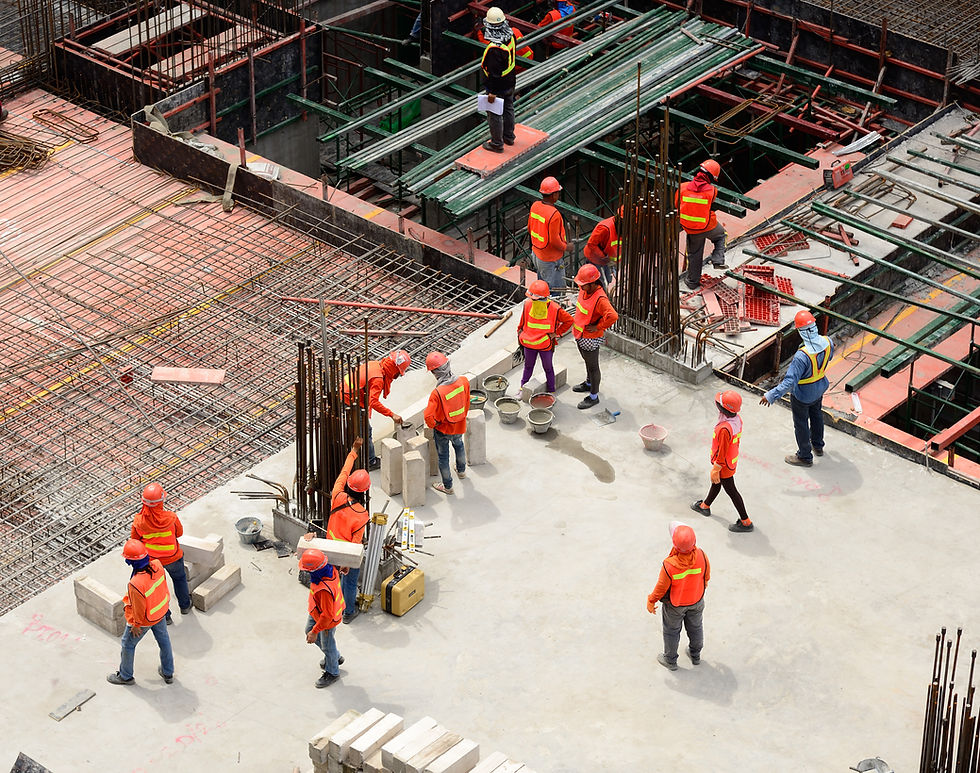Psychological Safety & the Impact on Team Performance in the Construction Industry
- coraleebeatty
- Feb 5
- 6 min read
I know, one more "safety" thing to learn about or take action on or to consider in running a business. It seems like the list of things that needs considering or addressing is never-ending. Just as we think we have a handle on one "critical component of success", another one is thrown our way.

I'm here to shed light on the shadows of doing business in this industry that may be sabotaging your success without you even realizing it. The ideas I bring to you are to plant seeds of the possibilities, all just pieces to a complex puzzle that, as you grow and develop, will find their way to the top of your priority list. As this is a people industry, the sooner these ideas find their way to the top of your priority list, the sooner things will become easier for you.
In the construction industry, the one thing we can always count on, is change. However, what remains constant is the need for strong, cohesive teams. The performance of your teams can directly determine the success or failure of a project and ultimately, your business. Beyond technical skills and experience, however, there’s a small, yet significant factor that often gets overlooked that we will be looking at today and that's psychological safety.
This concept might seem like it belongs in a corporate office rather than on a construction site, and the truth is, it can be a game-changer. Psychological safety is about creating an environment where employees feel comfortable speaking up, asking questions, or admitting mistakes without the fear of being blamed or ridiculed. For those of us leading in the construction industry, building this type of culture is about improving safety, efficiency, and innovation on the job site.
What Psychological Safety Means in Construction
Now, I know what some of you may be thinking, I thought it too before I really understood how these pieces fit together to build a successful business. This is not "...just one more thing..." you have to think about. This is not the time to get our backs up about "...this generation is too soft" or "...they have to toughen up..." The way I choose to see it is the more educated I can be on understanding people and meeting the needs of my people, the more potential I have for success.
Whether it's your own team members or clients, trade partners or other stakeholders, understanding human needs will take you a long way in building valuable relationships, and as I've said many times before, relationships are the foundation of success in business. We can waste a lot of energy fighting against the changing workforce, or we can invest that energy to learn to appreciate the differences and how the workforce of the future will actually lead to a more profitable and sustainable business.
Psychological safety is the belief that the workplace is a safe space for taking risks and expressing concerns. On a construction site, this could mean a foreperson feeling comfortable asking for clarification on a design plan or a worker reporting a potential safety hazard without fearing backlash. It's the confidence that their voice will be heard and respected, even when discussing sensitive or challenging issues. The importance of this can't be overstated, especially in such a high-risk environment.
To better understand the concept, think about physical safety—a top priority on any construction site. Just as you ensure that workers are equipped with protective gear and follow strict protocols to minimize accidents, psychological safety protects workers’ mental and emotional well-being. Both forms of safety are important to prevent harm and ensure smooth operations. While physical safety measures safeguard workers from immediate, tangible dangers, psychological safety is having an environment where practices like criticism, blame, or exclusion are not tolerated.
Similarly, mental health safety focuses on protecting workers from burnout, stress, and other mental health challenges. Where mental health safety often involves creating work environments that prevent overwork or providing people with tools and strategies to manage stress, psychological safety enables workers to speak up when they’re feeling overwhelmed or need support—without fear of judgment. It's the third piece to the safety trifecta.
When psychological safety is treated with the same importance as physical and mental health safety, the result is a holistic culture where team members are fully protected—physically, mentally, and emotionally. This leads to higher morale, better engagement, and, ultimately, improved performance across your teams.
How Site Leaders Can Build Psychological Safety
As business owners, we depend heavily on our site leaders to influence the culture and dynamics of the teams on the ground. Creating psychological safety isn’t about implementing sweeping policies; it’s about setting the tone day in and day out through small, intentional actions and this is a top-down practice. Here’s how site leaders can foster an environment where psychological safety thrives:
1. Foster Open Communication
Open communication is the foundation of psychological safety. Leaders must encourage dialogue where every team member feels comfortable contributing. The best ideas or insights often come from those closest to the work, so when your workers on the ground see a potential issue, they should feel encouraged to speak up without hesitation.
For example, making daily safety huddles part of your routine provides a space where workers can raise concerns or share observations about site conditions. These quick check-ins reinforce the idea that communication is expected and valued.
2. Focus on Learning, Not Blame
Mistakes are inevitable on-site, as they are in any fast-paced, high-stakes environment. However, how those mistakes are handled can make all the difference. If workers fear being blamed or penalized for errors, they’re more likely to hide problems, which can escalate into larger issues. By creating a culture that treats mistakes as learning opportunities and focuses on solutions, leaders foster an environment that encourages transparency and a proactive approach to problem-solving.
After any incident or misstep, a no-blame debrief is an effective tool. This creates space to reflect on what went wrong, what can be learned, and how to prevent it in the future, without pointing fingers.
3. Lead by Example with Vulnerability
This one is close to my heart and one I speak on often and that's learning to lead with vulnerability. One of the most effective ways leaders can foster psychological safety is by showing vulnerability themselves. When a site leader admits they don’t have all the answers or shares their own past mistakes or shows they are open to learn from the ones they are leading, it sends a powerful message that it’s okay not to be perfect. This simple act of humility can encourage others to be more open and honest as well.
For instance, a site manager who admits they’re unsure about a certain process and seeks input from their team models the type of behaviour that encourages others to ask questions without fear.
4. Incorporate Psychological Safety into Safety Culture
Physical safety is always a top priority on construction sites, and mental health safety and psychological safety should be woven into these protocols. Workers need to feel comfortable reporting near-misses or unsafe conditions, knowing they won’t face negative consequences for speaking up. This kind of openness enhances the overall safety culture and can prevent accidents before they happen.
Providing anonymous reporting options for safety concerns can help in situations where workers may still feel hesitant to speak up in front of peers or supervisors. This increases the likelihood that high-risk situations are identified and addressed without incident.
Why Psychological Safety Matters
Fostering psychological safety on your sites is about creating a better place to work (think retention) and getting better results (think profit). When workers feel psychologically safe, they are more likely to engage fully with their tasks and with one another. They’re also more likely to contribute ideas that lead to innovation, report safety issues before they turn into accidents, and stay loyal to your company because they know their contributions are valued.
Innovation Increases: Workers at all levels feel comfortable suggesting improvements to processes, leading to more efficient practices and creative problem-solving.
Safety Improves: Potential risks are identified earlier and acted upon, leading to fewer accidents and incidents.
Engagement Grows: Employees who feel respected and heard are more invested in the success of their team, leading to higher retention and overall satisfaction.
Performance Improves: Open communication and early error detection result in smoother project delivery and better financial outcomes.
As business owners, we know that our leadership and that of our site managers directly impact our teams' performance. Creating a culture of psychological safety is the right thing to do and is a strategic move that will enhance the effectiveness of your teams, improve safety, and lead to better project and business outcomes.
Change starts at the top, with you. I encourage you to challenge yourself and your leadership teams to focus on the technical and operational aspects of our projects, as well as fostering an environment where everyone feels supported to contribute. In doing so, you will unlock new heights of success.
If you are uncertain where to start to implement these tips into your organization, please feel free to reach out. I'm happy to provide further resources and guidance to help improve the state of our industry.








Comments